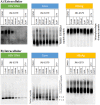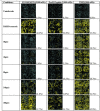Antiviral Properties and Mechanism of Action Studies of the Hepatitis B Virus Capsid Assembly Modulator JNJ-56136379
- PMID: 32094138
- PMCID: PMC7179615
- DOI: 10.1128/AAC.02439-19
Antiviral Properties and Mechanism of Action Studies of the Hepatitis B Virus Capsid Assembly Modulator JNJ-56136379
Abstract
Capsid assembly is a critical step in the hepatitis B virus (HBV) life cycle, mediated by the core protein. Core is a potential target for new antiviral therapies, the capsid assembly modulators (CAMs). JNJ-56136379 (JNJ-6379) is a novel and potent CAM currently in phase II trials. We evaluated the mechanisms of action (MOAs) and antiviral properties of JNJ-6379 in vitro Size exclusion chromatography and electron microscopy studies demonstrated that JNJ-6379 induced the formation of morphologically intact viral capsids devoid of genomic material (primary MOA). JNJ-6379 accelerated the rate and extent of HBV capsid assembly in vitro JNJ-6379 specifically and potently inhibited HBV replication; its median 50% effective concentration (EC50) was 54 nM (HepG2.117 cells). In HBV-infected primary human hepatocytes (PHHs), JNJ-6379, when added with the viral inoculum, dose-dependently reduced extracellular HBV DNA levels (median EC50 of 93 nM) and prevented covalently closed circular DNA (cccDNA) formation, leading to a dose-dependent reduction of intracellular HBV RNA levels (median EC50 of 876 nM) and reduced antigen levels (secondary MOA). Adding JNJ-6379 to PHHs 4 or 5 days postinfection reduced extracellular HBV DNA and did not prevent cccDNA formation. Time-of-addition PHH studies revealed that JNJ-6379 most likely interfered with postentry processes. Collectively, these data demonstrate that JNJ-6379 has dual MOAs in the early and late steps of the HBV life cycle, which is different from the MOA of nucleos(t)ide analogues. JNJ-6379 is in development for chronic hepatitis B treatment and may translate into higher HBV functional cure rates.
Trial registration: ClinicalTrials.gov NCT03361956.
Keywords: capsid; capsid assembly modulator; cccDNA; hepatitis; hepatitis B virus; primary human hepatocytes.
Copyright © 2020 American Society for Microbiology.
Figures






References
-
- World Health Organization. 18 July 2019. Hepatitis B. www.who.int/mediacentre/factsheets/fs204/en/index.html. Accessed 27 August 2019.
Publication types
MeSH terms
Substances
Associated data
LinkOut - more resources
Full Text Sources
Medical

